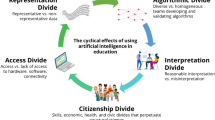Abstract
Digital literacy is now defined as a key area of competence in the new national curriculum for schools in Norway. For policy makers the terms ‘information society’ and ‘knowledge society’ has been used to argue for implementing new technologies in education, and for improving learning. These views have been highly problematic, partly because they do not take into consideration how new technologies are used by young people, or how schools work as social practices. This article will focus on how we conceptualize a student perspective in schools related to the use of digital technologies. Combining an increased focus on digital literacy in school curricula with an increased focus on student participation challenges our conception of the school-aged learner. In discussing these issues I will draw on results from a number of school-based ICT projects that I have been involved in since 1998.


Similar content being viewed by others
References
Barton, D. (1994). Literacy. An introduction to the ecology of written language. Oxford: Blackwell.
Bentley, T. (1998). Learning beyond the classroom. Education for a changing world. London: Routledge.
Bereiter, C. (2002). Education and mind in the knowledge age. New Jersey: Lawrence Erlbaum.
Bourdieu, P. (1984). Distinction: A social critique of the judgement of taste. London: Routledge.
Bransford, J. D., Brown, A. L., & Cocking, R. (2000). How people learn. Brain, mind, experience and school. Washington, District of Columbia: National Academy.
Buckingham, D. (2003). Media education. Learning, literacy and contemporary culture. Cambridge: Polity.
Cole, M., & Keyssar, H. (1985). ‘The concept of literacy in print and film’. In Olson, Torrance & Hildyard (Eds.), Literacy, language and learning. The nature and consequences of reading and writing. Cambridge, Massachusetts: Cambridge University Press.
Cope, B., & Kalantzis, M. (2000). Multiliteracies. Literacy learning and the design of social futures. London: Routledge.
Cuban, L. (1986). Teachers and machines: the classroom use of technology since 1920. New York: Teachers College.
Drotner, K. (2001). Medier for fremtiden. Børn, unge og det nye medielandskab. (Media for the future. Children, youth and the new media landscape) København: Høst & Søn.
Engeström, Y. (1987). Learning by expanding. An activity-theoretical approach to developmental research. Helsinki: Orienta-Konsultit Erlbaum.
Erstad, O. (2004). PILOTer for skoleutvikling (PILOTs for school development). UniPub. Report no. 28. ITU, University of Oslo.
Erstad, O. (2005). Digital kompetanse i skolen (Digital literacy in the school). Oslo: University Press.
Erstad, O., Frølich, T. H., Kløvstad, V., & Vestby, G. M. (2000). Den langsomme eksplosjonen (The slow explosion). UniPub. Report no. 11. ITU, University of Oslo.
Erstad, O., Kløvstad, V., Kristiansen, T. & Søby, M. (2005). ITU Monitor 2005—På vei mot digital kompetanse i grunnopplæringen. (ITU Monitor 2005—On the way towards digital literacy in basic education.) Oslo: University Press.
Fullan, M. (1993). Change forces. Probing the depths of educational reform. London: Falmer.
Graff, H. (1979). The literacy myth: Literacy and social structure in the nineteenth-century. New York: Academic.
Jonassen, D. H., & Land, S. M. (Eds.) (2000). Theoretical foundations of learning environments. New Jersey: Lawrence Earlbaum
Kozma, R. B. (2003). Technology, innovation and educational change. Eugene, Oregon: International Society for Technology in Education (ISTE).
Kubey, R. (Ed.) (1997). Media literacy in the information age. New Brunswick: Transaction.
Land, S. M., & Hannafin, M. J. (2000). ‘Student-centered learning environments’. In D. H. Jonassen & S. M. Land (Eds.) Theoretical foundations of learning environments. New Jersey: Lawrence Earlbaum.
Lankshear, C. (1997). Changing literacies. Buckingham: Open University Press.
Livingstone, S. (2002). Young people and new media. London: Sage.
Osterud, S. (2004). Utdanning for informasjonssamfunnet. Den tredje vei. (Education for the information society. The third way.) Oslo: Universitetsforlaget.
Qvortrup, L. (2001). Det lærende samfund. Hyperkompleksitet og viden. (The learning society. Hypercomplexity and knowledge.) København: Gyldendal.
Säljö, R. (2000). Lärande i praktiken. Et sociokulturellt perspektiv.(Learning in practice. A sociocultural perspective) Stockholm: Prisma förlag.
Snyder, I. (Ed.) (2002). Silicon literacies. Communication, innovation and education in the electronic age. London: Routledge.
Street, B. (1984). Literacy in theory and practice. Cambridge, UK: Cambridge University Press.
Tyner, K. (1998). Literacy in a digital world. Teaching and learning in the age of information. New Jersey: Lawrence Erlbaum.
Vygotsky, L. (1978). Mind in society. Cambridge, Massachusetts: Harvard University Press.
Warschauer, M. (1999). Electronic literacies. Language, culture and power in online education. New Jersey: Lawrence Erlbaum.
Warschauer, M. (2004). Technology and social inclusion: Rethinking the Digital Divide. Cambridge, Massachusetts: MIT.
Wells, G., & Claxton, G. (Eds.) (2002). Learning for life in the 21st century. Oxford, UK: Blackwell.
Wertsch, J. (1998). Mind as action. Oxford: Oxford University Press.
Ministry of Education (2004). Culture for learning. White paper no. 30 (2003–2004). Oslo: Ministry of Education.
Author information
Authors and Affiliations
Corresponding author
Rights and permissions
About this article
Cite this article
Erstad, O. A new direction?. Educ Inf Technol 11, 415–429 (2006). https://doi.org/10.1007/s10639-006-9008-2
Published:
Issue Date:
DOI: https://doi.org/10.1007/s10639-006-9008-2




